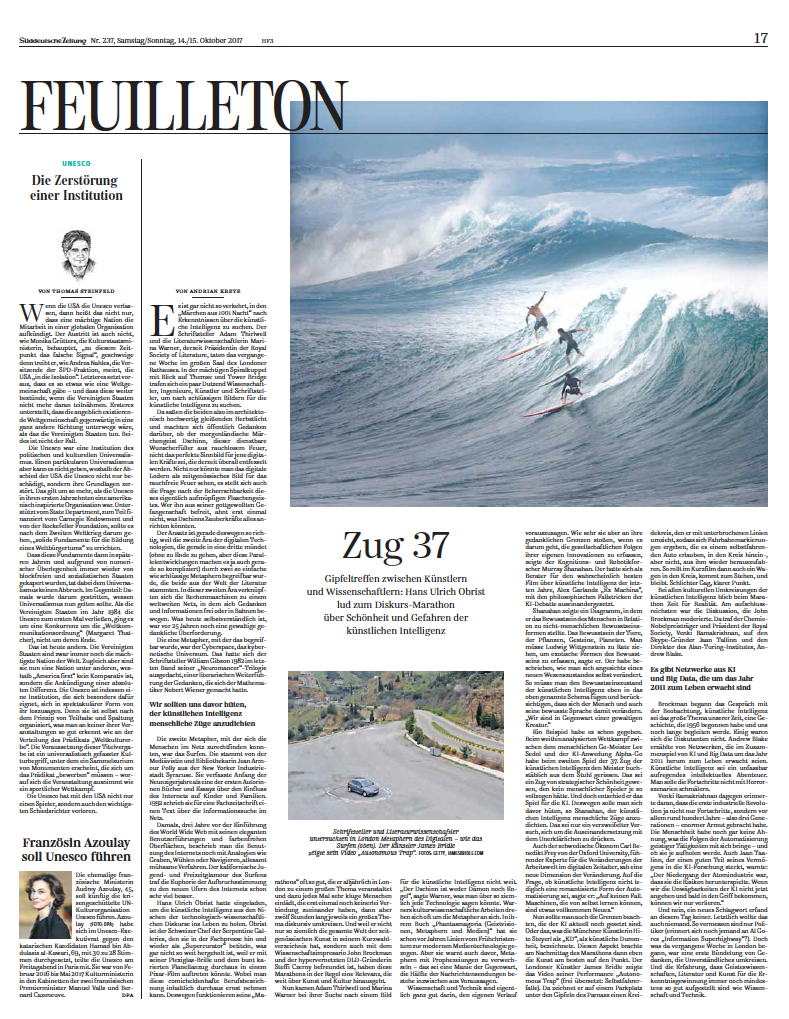The approach is just right, because the second era of digital technologies, which opens into a third (without ending, but these parallel developments also make it so complicated) can be understood by two simple as well as conclusive metaphors, both from the world of literature. In this second era, the computational machines linked to a worldwide network in which thoughts and information move freely or in orbit. What is a matter of course today was still a tremendous intellectual challenge 25 years ago.
The one metaphor that made it intelligible was cyberspace, the cybernetic universe, conceived by the writer William Gibson in 1982 in the last volume of his Neuromancer trilogy, a literary continuation of the ideas set forth by mathematician Norbert Wiener.
We Should Beware of Imposing Human Traits on Artificial Intelligence
The second metaphor that could be used to find people on the net was surfing. It comes from the media theorist and librarian Jean Armor Polly from the New York state industrial city of Syracuse. In the early 1990s she was one of the first authors to write books and essays on the influence of the Internet on children and families. In 1992, she wrote a text for a trade journal about the search for information on the web.
At the time, three years before the introduction of the World Wide Web, with its elegant user interfaces and colorful surfaces, the use of the Internet was still described with analogies such as digging, browsing or navigating, all of which were tedious procedures. The Californian youth and leisure glamour mode of surfing was a much better way to meet the euphoria of the awakening mood to the new shores of the Internet.
Hans Ulrich Obrist had invited the participants to broaden the frame for a discussion of artificial intelligence beyond the niches of technological and scientific discourses. Obrist is the Swiss director of the Serpentine Gallery, often called by the mainstream press as the "supercurator," which is not so far-fetched because with his plexiglass glasses and the multicolored plaid flannel suit, he could be starring in a Pixar film. His comic-heroic professional title should be taken seriously. That's why his "Marathons," which he organizes every year in London, often work so well. He chooses a big topic and invites very clever people who have no connection to each other, to engage on a discursive discussion over a twelve-hour period. Because he has not only much the entire world of contemporary art on his contacts list, and he is also friends with the scientific impresario John Brockman and the Hyper-netizen DLD founder Steffi Czerny, these marathons usually have a relevance that goes far beyond the culture of the art world.
Reaching the Limits of Thought
Science and technology are quite good at predicting their own course. However, Murray Shanahan, the cognitive and robotics researcher, showed how much they encounter their intellectual limits when it comes to grasping the societal consequences of their own innovations. He was a consultant for what is probably the best film about artificial intelligence in recent years, Alex Garland's Ex Machina, which explored philosophical pitfalls of the AI debate.
Shanahan showed a diagram in which he presented human consciousness in relation to non-human forms of consciousness: the consciousness of animals, plants, rocks, planets. One must consult Ludwig Wittgenstein to grasp exotic forms of consciousness, he said. He described how to change oneself in the face of a new state of being. Thus, the state of consciousness of the artificial intelligence must be inserted into the above-mentioned scheme, taking into account the fact that man and his conscious language change with it. "We are in the presence of a formidable creature."
An example already existed. In the widely-analyzed competition between the human Go champion Lee Sedol and the AI Alpha-Go. In the 37th move second game of the 2nd game, the move by the AI literally tore the master out of his chair. It was a move of strategic beauty that no human player ever accomplished. And it was decisive in winning the game for the AI. Therefore, said Shanahan, one should be wary of comparing artificial intelligence to human characteristics. This becomes a desperate attempt of pushing the discussion with the unexplainable.
With all cultural orbits within which artificial intelligence was discussed, the Marathon had time for reality. Most interesting was the discussion moderated by John Brockman. Venki Ramakrishnan, the Nobel laureate of chemistry and president of the Royal Society, met the Skype founder Jaan Tallinn and the director of the Alan Turing Institute, Andrew Blake.
There are networks of AI and Big Data, which have come to life around the year 2011
Brockman began the conversation with the observation that artificial intelligence is the great theme of our time, a story that began in 1956 and will continue to accompany us for a long time. The debaters did not agree. Andrew Blake told of networks that had come together in the interplay of AI and Big Data around the year 2011 to life. Artificial intelligence is an incredibly exciting intellectual adventure. Progress should not be mitigated with horror scenarios.
Venki Ramakrishnan, on the other hand, recalled that the first industrial revolution had brought not only progress, but, above all, over a hundred years, three generations, of enormous poverty. Humanity still has no idea what the consequences of the automation of mental activities entail—and whether it will ever catch up. Jaan Tallinn, who made a good part of his fortune in AI research, also warned: "The decline of the nuclear industry was that it downplayed the risks. If we do not tackle the uncertainties of the AI now and get to grips soon, we can only lose."
First printed in German by Süddeutsche Zeitung, October 13, 2017.


